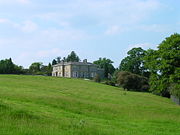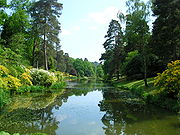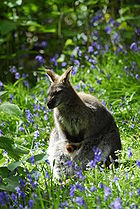
Leonardslee
Encyclopedia




Lower Beeding
Lower Beeding is a village and civil parish in the Horsham District of West Sussex, England. It lies on the B2110, B2115 and A281 roads 3.5 miles southeast from Horsham...
, near Horsham
Horsham
Horsham is a market town with a population of 55,657 on the upper reaches of the River Arun in the centre of the Weald, West Sussex, in the historic County of Sussex, England. The town is south south-west of London, north-west of Brighton and north-east of the county town of Chichester...
, West Sussex
West Sussex
West Sussex is a county in the south of England, bordering onto East Sussex , Hampshire and Surrey. The county of Sussex has been divided into East and West since the 12th century, and obtained separate county councils in 1888, but it remained a single ceremonial county until 1974 and the coming...
.
Following the sale of the estate in July 2010, the gardens are no longer open to the public.
Main features
The gardens, which are overlooked by a 19th century Italianate house, were started in 1801 and cover 200 acres of a steep sandstoneSandstone
Sandstone is a sedimentary rock composed mainly of sand-sized minerals or rock grains.Most sandstone is composed of quartz and/or feldspar because these are the most common minerals in the Earth's crust. Like sand, sandstone may be any colour, but the most common colours are tan, brown, yellow,...
valley, in which there are a series of seven man-made ponds, some of which once provided power for the Wealden iron industry
Wealden iron industry
The Wealden iron industry was located in the Weald of south-eastern England. It was formerly an important industry, producing a large proportion of the bar iron made in England in the 16th century and most British cannon until about 1770. Ironmaking in the Weald used ironstone from various clay...
. Victorian
Victorian era
The Victorian era of British history was the period of Queen Victoria's reign from 20 June 1837 until her death on 22 January 1901. It was a long period of peace, prosperity, refined sensibilities and national self-confidence...
plant collector Sir Edmund Loder purchased the estate from his parents-in-law in 1889 and planted extensive collections of Rhododendron
Rhododendron
Rhododendron is a genus of over 1 000 species of woody plants in the heath family, most with showy flowers...
s and Azalea
Azalea
Azaleas are flowering shrubs comprising two of the eight subgenera of the genus Rhododendron, Pentanthera and Tsutsuji . Azaleas bloom in spring, their flowers often lasting several weeks...
s and many species of trees. The garden is listed Grade I in the English Heritage
English Heritage
English Heritage . is an executive non-departmental public body of the British Government sponsored by the Department for Culture, Media and Sport...
Register of Parks and Gardens of Special Historic Interest in England
National Register of Historic Parks and Gardens
In England, the Register of Historic Parks and Gardens of special historic interest in England provides a listing and classification system for historic parks and gardens similar to that used for listed buildings. The register is managed by English Heritage under the provisions of the National...
. An unusual feature, for England, is the colony of wallabies
Wallaby
A wallaby is any of about thirty species of macropod . It is an informal designation generally used for any macropod that is smaller than a kangaroo or wallaroo that has not been given some other name.-Overview:...
which have grazed the grass in the gardens for over a century. A rock garden near the house was built c.1890 by the famous Victorian landscaping company James Pulham and Son
James Pulham and Son
James Pulham and Son was a firm of Victorian landscape gardeners and terracotta manufacturers which exhibited and won medals at London's Great Exhibition of 1851 and 1862 International Exhibition.-History:...
, who also built a mound containing artificial caves for mouflon
Mouflon
The mouflon is a subspecies group of the wild sheep Ovis aries. Populations of Ovis aries can be partitioned into the mouflons and urials or arkars...
, now used for the wallabies. The gardens, which also contained a collection of Victoria motor cars, a miniature exhibition called Beyond the Doll's House, and a display of modern outdoor sculptures, attracted some 50,000 visitors per year.
History
The name Leonardslee derives from the lea or valley of St Leonard's ForestSt Leonard's Forest
St. Leonard's Forest is at the western end of the Wealden Forest Ridge which runs from Horsham to Tonbridge, and is part of the High Weald Area of Outstanding Natural Beauty. It lies on the ridge to the south of the A264 between Horsham and Crawley with the villages of Colgate and Lower Beeding...
, one of the ancient forests of the High Weald. In the Middle Ages the soil was too acidic for agriculture and so it remained as a natural woodland with wild animals and deer for the chase. There was extensive felling of the forest trees in the 16th and 17th centuries as Sussex became the centre of England's iron industry, producing cannon and cannon balls, firebacks, hinges, horseshoes and nails. The local sandstone was rich in iron and the ore was dug from surface pits. A wood to the south of Leonardslee is still called Minepit Wood and its surface is pockmarked with ancient ore diggings. Most of the forest trees were felled for charcoal, which was used to reduce the ore and to generate heat to smelt it. The valley streams were dammed to provide a head of water that powered, via a water wheel, bellows that blasted air into the furnace, which was called Gosden furnace. Such a furnace would typically operate non-stop day and night and so it required a great deal of water to keep it going. A string of ponds was therefore created through a series of dams in the long, steep-sided valley to act as reservoirs; these would be drained as necessary to keep the flow of water going over the wheel. With the demise of the Sussex iron industry in the 17th century Gosden furnace was silenced, leaving behind the ponds, which later became such a picturesque feature of the gardens, and allowing the woodlands to regenerate.
King Charles II
Charles II of England
Charles II was monarch of the three kingdoms of England, Scotland, and Ireland.Charles II's father, King Charles I, was executed at Whitehall on 30 January 1649, at the climax of the English Civil War...
granted the lands of St Leonard's Forest to his physician, Sir Edward Greaves, and from him they were passed down to the Aldridge family. A portion of the Aldridge estate was sold in 1801 to Charles G. Beauclark, who erected a house called St Leonard's Lodge on the site of the present mansion. By this time the denudations of the iron works had been replaced by more than a century of natural regeneration. The estate was now lightly wooded, mainly with oak, beech and chestnut, with some ancient pines and larch plantations. It was the Beauclerk family who were responsible for the first ornamental plantings. They seem to have run into financial difficulties, and in 1852 they sold the estate to the Hubbard family, who built the present Italianate style house, designed by Thomas Donaldson, the first Professor of Architecture at University College London, which was completed in 1855.
Edmund Loder from Flore
Flore, Northamptonshire
Flore is a village and civil parish in the Daventry district of the county of Northamptonshire in England. The A45 road divides the upper part of the village from several older, lower streets. The population at the 2001 census was 1,221.- External links :...
, in Northamptonshire
Northamptonshire
Northamptonshire is a landlocked county in the English East Midlands, with a population of 629,676 as at the 2001 census. It has boundaries with the ceremonial counties of Warwickshire to the west, Leicestershire and Rutland to the north, Cambridgeshire to the east, Bedfordshire to the south-east,...
married Marion Hubbard in 1876 and bought the property from his parents-in-law in 1889. He planted a large amount of exotic flora in a short time and also introduced gazelle
Gazelle
A gazelle is any of many antelope species in the genus Gazella, or formerly considered to belong to it. Six species are included in two genera, Eudorcas and Nanger, which were formerly considered subgenera...
, beaver
Beaver
The beaver is a primarily nocturnal, large, semi-aquatic rodent. Castor includes two extant species, North American Beaver and Eurasian Beaver . Beavers are known for building dams, canals, and lodges . They are the second-largest rodent in the world...
s, kangaroo
Kangaroo
A kangaroo is a marsupial from the family Macropodidae . In common use the term is used to describe the largest species from this family, especially those of the genus Macropus, Red Kangaroo, Antilopine Kangaroo, Eastern Grey Kangaroo and Western Grey Kangaroo. Kangaroos are endemic to the country...
s and wallabies
Wallaby
A wallaby is any of about thirty species of macropod . It is an informal designation generally used for any macropod that is smaller than a kangaroo or wallaroo that has not been given some other name.-Overview:...
. He had a rock mound with caves built by James Pulham to house mouflon
Mouflon
The mouflon is a subspecies group of the wild sheep Ovis aries. Populations of Ovis aries can be partitioned into the mouflons and urials or arkars...
, and these are now used as shelter by the wallabies. The Pulhams built the rock garden c.1890 using a mixture of natural and artificial cretaceous sandstone. The rock garden is of moderate size and surrounded with conifers to provide shelter. The last Loder to own Leadonardslee, Robin Loder, made four new lakes and new plantings on the east side of the valley.
In February 2010 it was announced that estate had been sold by the Loder family to an international businessman and that after the 2010 season, from April to June, the gardens would be closed to the public. The gardens were duly closed on 30 June 2010; there are currently no plans for Leonardslee to be re-opened to the public in the future.

